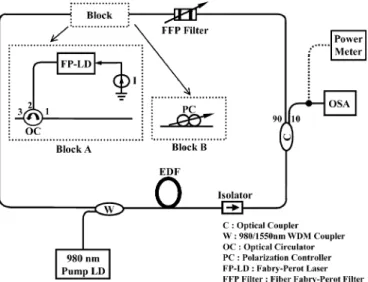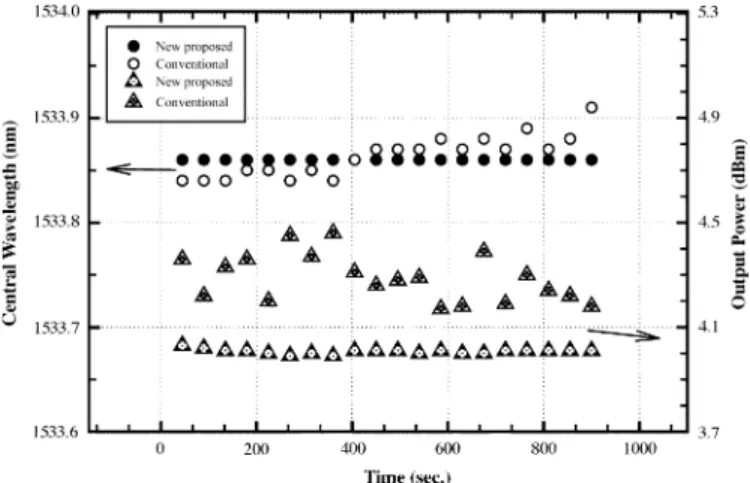IEEE PHOTONICS TECHNOLOGY LETTERS, VOL. 16, NO. 3, MARCH 2004 765
A Stabilized and Tunable Erbium-Doped Fiber Ring
Laser With Double Optical Filter
Chien-Hung Yeh, Chien-Chung Lee, Chih-Yang Chen, and Sien Chi
Abstract—We have proposed and experimentally demonstrated
a stabilized and tunable erbium-doped fiber ring laser by using a Fabry–Pérot laser and a fiber Fabry–Pérot filter. The sidemode suppression ratio of 30 dB/0.1 nm and the output power of 2.2 dBm can be achieved while this ring laser is tuned from 1528.28 to 1559.64 nm with the step of 1.12 nm. The wavelength variation of less than 0.01 nm and the power fluctuation of 0.04 dB have also been obtained. When the constant output power is controlled by adjusting the bias current of 980-nm pump laser, the power variation of less than 0.05 dB can be obtained over the entire tunable range.
Index Terms—Erbium-doped fiber amplifier (EDFA), Fabry–Pérot laser (FP-LD), fiber ring laser.
I. INTRODUCTION
T
UNABLE stable frequency and constant power are needed for fiber ring lasers applied on wavelength-division-mul-tiplexing (WDM) communication and optical sensor systems. Conventionally, fiber Fabry–Pérot (FFP) filters can provide wavelength tuning for fiber ring lasers. However, it is insuffi-cient to stabilize the lasing wavelength and power of a fiber ring laser. Recently, several techniques, such as integrating two cascaded FFP filters of widely different free spectral ranges (FSRs) into cavity [1], [2], employing a compound ring resonator composed of a dual-coupler fiber ring and a tunable bandpass filer [3], and adding an extra ITU-grid periodic filter in the optical loop [4], have been reported.In this letter, a new method employing a Fabry–Pérot laser (FP-LD) and an FFP filter for the stabilized and tunable erbium-doped fiber (EDF) ring lasers has been proposed and experi-mentally investigated. The performances of the tunable range, wavelength and power stabilities, sidemode suppression ratio (SMSR), and constant power control have also been studied.
II. EXPERIMENTS
The proposed and experimental setup for the stabilized EDF ring laser is shown in Fig. 1. This ring laser constructed by a 1 2 and 10 : 90 optical coupler, an optical circulator, an intracavity FFP filter, a multilongitudinal-mode FP-LD with 1.12-nm mode spacing, and an erbium-doped fiber amplifier (EDFA) module. This amplifier module is composed of a 980/1550-nm WDM
Manuscript received August 28, 2003; revised October 29, 2003. This work was supported in part by the Academic Excellence Program of R.O.C. Ministry of Education under Contract 89-E-FA06-1-4 and the National Science Council of R. O. C. under Contract NSC-92-2215-E-009-008.
The authors are with the Institute of Electro-Optical Engineering, Na-tional Chiao Tung University, Hsinchu, Taiwan 30050, R.O.C. (e-mail: depew.eo89g@nctu.edu.tw).
Digital Object Identifier 10.1109/LPT.2004.823771
Fig. 1. Proposed and experimental setup for the stabilized EDF ring laser.
coupler, an optical isolator, a 12-m-long EDF (HighWave-741), and a 980-nm pump laser with the power of 100 mW while the bias current operated at 180 mA. The central wavelength of FP-LD is 1533.84 nm at the bias current of 15 mA. In addi-tion, the FFP filter has a wide tunable low loss of 0.5 dB, and low polarization-dependent loss of 0.1 dB. The FFP filter with FSR of 44.5 nm and finesse of 200 can select the lasing wave-length in the ring cavity by applying external voltage ( 12 V) on the piezoelectric transducer (PZT) of FFP filter. Besides, the FP-LD is also used inside the ring cavity in the proposed fiber ring laser for the wavelength filtering and lasing.
To provide the stable frequency operation, the central wave-length of the FFP filter passband is tuned to align and the longi-tudinal-mode FP-LD for wavelength lasing. Therefore, 1.12-nm tuning step is determined by the longitudinal-mode spacing of the FP-LD. This way, the sidemodes of the FP-LD are sup-pressed and the optical output amplified while the bias current operated at 15 mA. The output spectra and powers are observed by using an optical spectrum analyzer and a power meter. Com-pared with conventional fiber ring laser operation [1]–[3], the FP-LD and the optical circulator are removed but a polarization controller (PC) is placed into the ring cavity in order to control the polarization state and maintain the output wavelength and power stabilization.
III. RESULTS ANDDISSCUSSIONS
This proposed ring laser can retrieve a stabilized single frequency output. Fig. 2(a) shows the optical spectra of the ring laser while different external voltages applied on the PZT of
766 IEEE PHOTONICS TECHNOLOGY LETTERS, VOL. 16, NO. 3, MARCH 2004
Fig. 2. (a) Optical spectra for the ring laser while the external voltages of 0 to 12 V applied on the PZT of FFP filter over tunable range from 1528.28 to 1559.64 nm. (b) Output power and the SMSR versus the different lasing wavelength with 1.12-nm tuning step over the tunable range.
FFP filter. The lasing wavelength can be tuned from 1528.28 to 1559.64 nm. From Fig. 2(a), the ring laser has lower amplified spontaneous emission at 1540.00 nm. Fig. 2(b) indicates the output power and the SMSR versus the different lasing wave-length with 1.12-nm tuning step. The maximum output power of 4.1 dBm is observed at 1539.48 nm. As seen in Fig. 2(b), the SMSR and output power are larger than 30 dB/0.1 nm and 2.2 dBm, respectively, for the tuning range over 31.36 nm (1528.28–1559.64 nm). When a lasing wavelength operated at 1535.00 nm, the SMSR is up to 40.6 dB/0.1 nm. In addition, the stabilized output of this ring laser can be observed without using a PC. As a result, the SMSR of 30 dB/0.1 nm and the output power of 2.2 dBm can be retrieved while this ring laser is tuned from 1528.28 to 1559.64 nm with the step of 1.12 nm. The FP-LD operated at 25 C. A different temperature could cause the central wavelength of the LD to slightly shift. There-fore, the lasing wavelength, by controlling the temperature of the LD, could be continued tunable.
To investigate the performances of power and wavelength stabilities, the short-term stability of the proposed structure (Block A inserted in Fig. 1) is measured and compared with that of the conventional architecture (Block B inserted in Fig. 1), as
Fig. 3. Wavelength variation and the power fluctuation for the conventional and proposed ring laser. Lasing wavelength is 1533.86 nm initially and the observing time is over 900 s.
Fig. 4. Constant output power of 2.1 dBm and the bias current of 980-nm pump laser operated between 135 and 175 mA versus the lasing wavelength over the tunable range from 1528.28 to 1559.64 nm.
shown in Fig. 3. The lasing wavelength is 1533.86 nm initially and the observing time is over 900 s. In Fig. 3, the wavelength variation and the power fluctuation for the conventional ring laser are 0.07 nm and 0.22 dB, respectively. The proposed ring laser can dramatically reduce the wavelength variation to zero readout resolution nm and power fluctuation to 0.04 dB. During a 4-h observation, the stabilized output of the proposed ring laser is still maintained. The threshold current of FP-LD was 9 mA. The slope efficiency of this proposed laser is near 15%. For this proposed ring laser, the bias current of the FP-LD can be operated between 9 and 15 mA for wavelength tuning. The larger current level can obtain greater optical output. When the bias current is above 15 mA, the sidemode of the ring laser cannot be suppressed. The external injection into FP-LD can lock mode for stabilized single frequency output. Compared with a conventional fiber ring laser, this laser has more stable output. However, the limitations of this ring laser are limited by the gain of EDF and bandwidth of FP-LD.
By adjusting the bias current of 980-nm pump laser in the cavity, the ring laser can keep the constant output power. Fig. 4 shows the output power and the bias current of 980-nm pump
YEH et al.: STABILIZED AND TUNABLE EDF RING LASER WITH DOUBLE OPTICAL FILTER 767
laser versus lasing wavelength under the constant power con-trol. When the output power of the ring laser is set at 2.1 dBm, the power variation of less than 0.05 dB can be obtained in a tunable range from 1528.28 to 1559.64 nm by adjusting the bias current between 135 and 175 mA.
IV. CONCLUSION
A stabilized and tunable EDF ring laser by using an FP-LD and an FFP filter has been proposed and experimentally demon-strated. The SMSR of 30 dB/0.1 nm and the output power of 2.2 dBm can be retrieved while this ring laser is tuned from 1528.28 to 1559.64 nm with the step of 1.12 nm. The wave-length variation of less than 0.01 nm and the power fluctuation of 0.04 dB have also been obtained. When the constant output power is controlled by adjusting the bias current of 980-nm
pump laser, the power variation of less than 0.05 dB can be achieved over the entire tunable range. This proposed stabiliza-tion technique is expected to benefit the ring laser applicastabiliza-tions.
REFERENCES
[1] K. J. Vahala, P. Namkyoo, J. Dawson, and S. Sanders, “Tunable, single-frequency, erbium fiber ring lasers,” in IEEE LEOS ’93 Conf. Proc., 1993, pp. 708–709.
[2] K. K. Chow, C. Shu, M. W. K. Mak, and H. K. Tsang, “Widely tun-able wavelength converter using a double-ring fiber laser with a semi-conductor optical amplifier,” IEEE Photon. Technol. Lett., vol. 14, pp. 1445–1447, Oct. 2002.
[3] R. M. Sova, K. Chang-Seok, J. U. Kang, and J. B. Khurgin, “Tunable dual-/spl lambda/fiber ring laser based on 2/sup nd/order Sagnac-Lyot fiber filter,” in IEEE CLEO 2002 Tech. Dig., vol. 1, 2002, pp. 444–445. [4] A. Bellemare, J.-F. Lemieux, M. Tetu, and S. LaRochelle, “Erbium-doped fiber ring lasers step-tunable to exact multiples of 100 GHz (ITU-grid) using periodic filters,” in Proc. Eur. Conf. Optical Communications

